
This is free.
Mechanised production thinning of radiata pine - A viable option for small-scale growers
John Schrider and Jack Palmer, New Zealand Tree Grower February 2022.
This article is the third in a series looking at mechanised harvesting options for small-scale forest growers. It is on a work study carried out to assess the productivity of a fully mechanised production thinning system operating successfully in Southland. From the study it was possible to develop some estimates of thinning costs to enable comparison with more conventional costs. We believe that in some circumstances, production thinning could become more viable for small-scale forest growers in the future.
Thinning radiata pine crops in early or mid-rotation is recommended practice, regardless of the plantation size and whether the trees have been pruned or not. Production thinning of radiata pine – where the felled trees are extracted and used – is much less common than thinning to waste, where felled trees are left to decay in the forest. Fully mechanised production thinning of radiata pine is rarely undertaken by small-scale growers.
Poor economies of scale, lack of market access and lack of specialised small-scale contractors with appropriate equipment all mean that thinning to waste remains the most realistic management option, if the forest or woodlot is thinned at all.
In contrast, fully mechanised production thinning systems have been operating in some corporate forestry set-ups for several decades for radiata pine and Douglasfir plantations. These systems are most likely to be commercially viable in forests located close to a market for the thinning products with land conducive to full mechanisation.
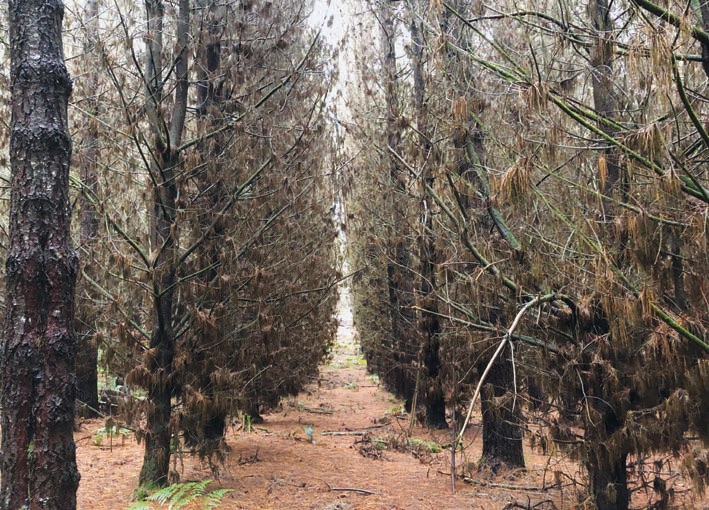
John Fodie’s harvest system
A mechanised production thinning operation working in small forests in Southland was recently analysed by Forme Consulting. In the case study, a fully mechanised crew was belatedly thinning relatively small 20-year old radiata pine stands. Markets exist for the products at the nearby Daiken Mataura medium density fibreboard plant, while small export grade logs go for export via the nearby port of Bluff.
The radiata was planted at 1000 stems a hectare − four metres by 2.5 metres. The trees had received variable pruning but no previous thinning.
One motivating factor for the thinning operation is that the crop has suffered from nectria canker Nectria fuckeliana, which afflicts some radiata pine forests in the southern South Island. The thinning operation, down to approximately 500 stems a hectare, was to improve the health and vigour of the final crop for growing to a later harvest age at 30 years. This was deemed preferable to clear felling at the current age and replanting.
Removing infected stems increases the average quality and value of the remaining stems.
The study
This study’s purpose was to determine forwarder and processor cycle times rather than undertake a full financial analysis of the thinning operation. Daily production estimates were calculated, followed by machinery and full operation costs on a per tonne and per day basis.
Contractor John Fodie’s operation was studied over four days in early June 2021.
The system consisted of three machines −
- Hyundai Robex 14-tonne excavator with Satco 214 felling and processor head
- John Deere 1210E forwarder equipped with bogie wheel band tracks
- Hitachi Z-Axis 225 excavator loader stationed at the roadside for forwarder unloading, stacking and truck loading.
The two-man crew consisted of the owner, John Fodie, who operated the feller and processor and controlled the bush operations, along with Roger Hill, the forwarder and loader operator who also loaded trucks. The crew used newly constructed forest roads to get to the stands, with relatively small log accumulation and load-out waysides spaced over the road network.
No forest stand inventory data was available. The estimated extracted tree size was between 0.5 and 0.7 cubic metres for each tree stem. Extracted processed log length was variable, but six metre lengths with a minimum 10 cm small end diameter went to the local medium density fibreboard plant to be chipped. The shorter logs went for export as grade K and KX logs.
The feller and processor cycle
The cycle of tree-felling and processing follows a repetitive pattern, each element of which was timed to determine average operation times.
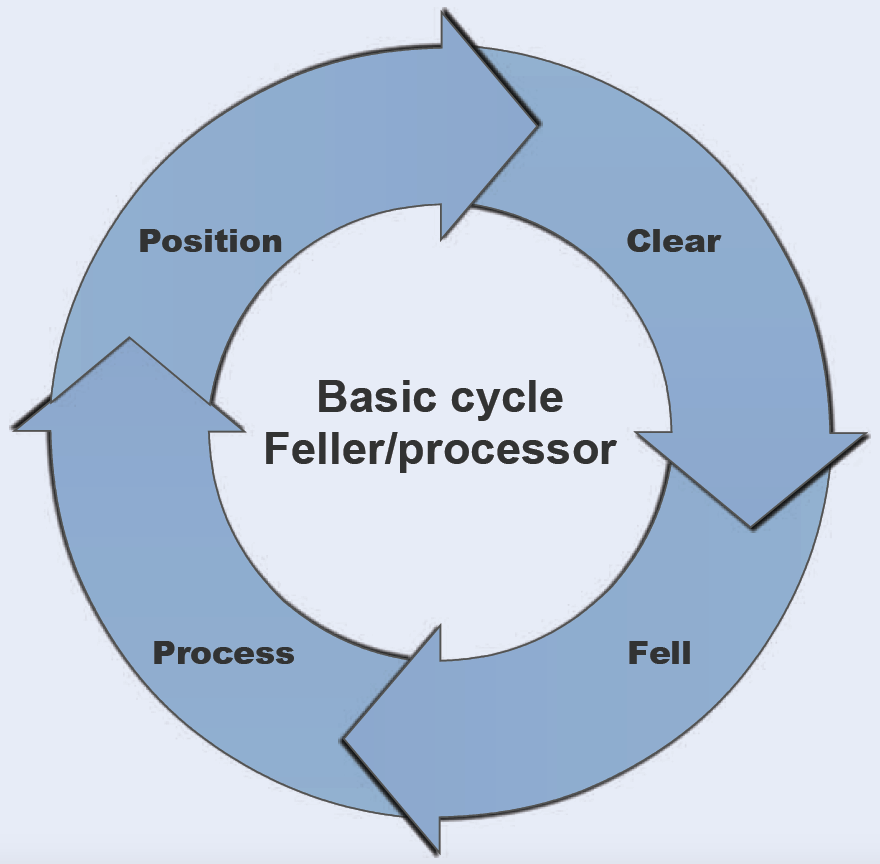
- Position – the machine is positioned adjacent to the tree to be felled.
- Clear – clearing of under-scrub or low branches to reach the tree.
- Fell – clamp the tree, fell and bring to ground.
- Process – de-limb, cut to length and stack.
Felling and processing are carried out for each tree cycle, but clearing and positioning may not take place each cycle. Felling dead trees does not incur any processing time but may involve some dead stem reduction to separate from residual stems or spread to enable better decomposition.
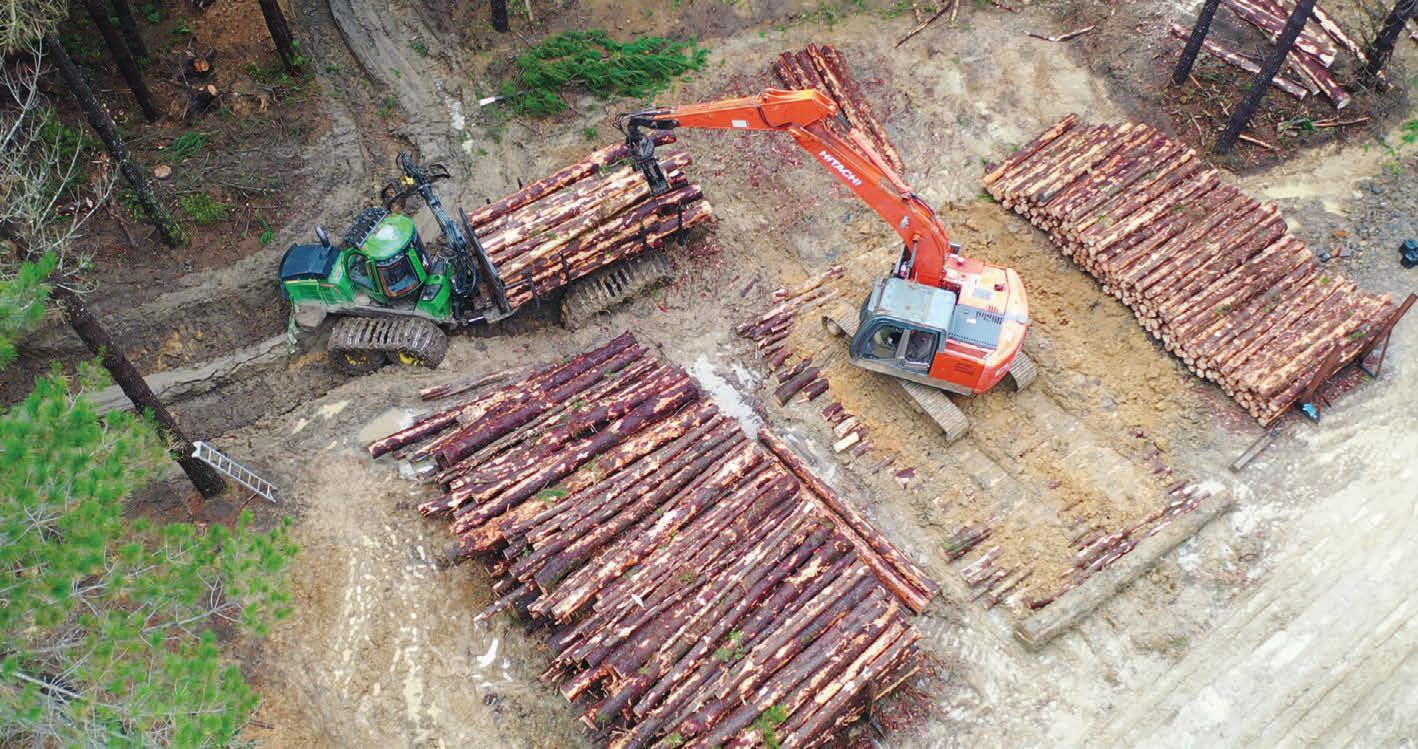
The forwarder cycle was also timed. The cycle time varied with the distance the forwarder had to travel between the log collection points and the load-out site.
The table below shows that, when industry standard allowances of just over 30 per cent are made for unavoidable unproductive time, a complete felling and processing cycle took 3 minutes and 40 seconds.
| Element | Standard time per tree in minutes and seconds |
|---|---|
| Clear | 0.28 |
| Fell | 0.58 |
| Position | 0.49 |
| Process | 1.34 |
| Fell dead | 0.09 |
| Total | 2.78 |
| Target calculation | Minutes and seconds per tree |
|---|---|
| Position | 0.30 |
| Clear | 0.17 |
| Fell live tree | 0.35 |
| Fell dead tree | 0.40 |
| Process live tree | 1.20 |
| Process dead tree | 0.10 |
| Total cycle per tree | 2.47 |
| Add 32 per cent allowance | 3.40 |
| Summary for daily production | |
| Cycles per day | 131 |
| Volume per day for 0.5 cubic metre tree | 65.50 cubic metres |
| Volume per day for 0.7 cubic metre tree | 91.70 cubic metres |
| Minutes and seconds per cycle | |||
|---|---|---|---|
| 200 metres | 175 metres | 250 metres | |
| Travel unloaded | 3.31 | 3.10 | 4.13 |
| Position | 1.43 | 1.43 | 1.43 |
| Load | 20.23 | 20.23 | 20.23 |
| Travel loaded | 5.14 | 4.40 | 6.22 |
| Unload | 12.08 | 12.08 | 12.08 |
| Total cycle time | 43.00 | 42.05 | 44.50 |
| Add allowances at 32 per cent | 56.40 | 63.21 | 59.29 |
| Summary for daily production | |||
| Cycles per 8-hour day | 8.47 | 8.65 | 8.12 |
| Production with 0.125 cubic metre piece | 62.01 cubic metres | 63.35 cubic metres | 59.48 cubic metres |
| Production with 0.175 cubic metre piece | 86.81 cubic metres | 88.70 cubic metres | 83.28 cubic metres |
This figure can then be extrapolated to give the number of feller and processor cycles each day, and estimated output in cubic metres for different tree sizes. The calculations for the forwarding operation are slightly more complex. The forwarder travels a range of distances as well as loading and unloading a range of log sizes.
Many factors influence the overall productivity of a harvesting operation including forwarder travel distance, feller and processor access distance, crew allocation of duties including truck loading, number of trucks loaded each day and variability in tree size. This system did appear to be well balanced, although the forwarder’s productivity was shown to be the controlling cycle at 62 to 87 cubic metres a day with a 200 metre lead distance, depending on the tree size.
Machine costing
A basic understanding of the ball-park financial costs of any harvesting contractor’s operation may not be essential for small-scale forest growers. However, it helps to appreciate why these contractors need to remain focused on high rates of productivity.
Varying methods are available to estimate daily machine operating costs. These can be combined with productivity data to estimate costs per day and tonnes of logs produced in any harvesting operation. Machinery costs are a combination of the fixed costs of owning a machine and the operating costs. The tables below show estimates for the three machines used in this production thinning operation.
| Processor | Forwarder | Loader | |
|---|---|---|---|
| Depreciation | $56,950 | $42,879 | $29,482 |
| Interest/risk | $20,121 | $28,579 | $13,877 |
| Insurance | $13,606 | $19,432 | $9,392 |
| Repairs and maintenance | $50,377 | $34,206 | $29,173 |
| Fuel | $18,073 | $23,660 | $14,368 |
| Oil | $2,050 | $3,470 | $1,625 |
| Tyres | $13,440 | ||
| Overheads | $11,289 | $13,003 | $12,700 |
| Total each year | $172,465 | $178,670 | $110,616 |
| Total each day | $734 | $760 | $471 |
In the case of this study, the data reveals that the probable costs incurred by this small two-man, three machine operation are estimated at around $3,260 each day which is over $16,000 a week. Estimated operational costs per tonne of output are in the table below. Of interest is the $15 per cubic metre differential between the smaller and larger log sizes.
Processing and extracting small logs is expensive. The forest owner decided that the revenue generated from thinning sales, combined with the removal of nectria-infected trees and increased productivity and value of the remaining trees, makes the production thinning a viable operation.
| Cost per day | |
|---|---|
| Crew accessories | $79 |
| Power saw | $50 |
| Vehicles - two at 60 km | $180 |
| Processor | $734 |
| Forwarder | $760 |
| Loader | $471 |
| Wages and travel-owner | $553 |
| Wages and travel-operator | $437 |
| Total | $3,264 |
| Indicative costs per tonne | |
|---|---|
| Dollars each day | $3,264 |
| Tree size 0.5 cubic metres - 62 cubic metres a day | $53 |
| Tree size 0.7 cubic metres − 87 cubic metres a day | $38 |
Production thinning options for small growers
Thinning radiata pine is an essential operation if growth rates and final crop values are to be optimised. However, thinning costs money. With chainsaw crews becoming increasingly expensive and hard to find, the risk is that small-scale owners neglect thinning. Mechanised production thinning may present an alternative, especially if there is a market for the timber to at least help offset some of the costs of the operation.
Small-scale forest growers considering a production thinning operation may need to bear the following in mind:
- The condition and current state of the stand which will include age, size, topography, and previous silviculture treatment. Stocking rates will be important for equipment accessibility where small highly manoeuvrable machines which leave little damage to the residual crop but are still able to remove the relevant trees. Smaller, more powerful and sophisticated felling and extraction equipment are increasingly available.
- The health of the stand. In this case production thinning was undertaken predominantly as an operation to control nectria. Wind damaged stands, where access for personnel with chainsaws is dangerous, could also be considered for production thinning as a tidy-up operation.
- Access to a suitable market. In this case the Daiken Mataura mill is an outlet for pulp grade material and small export material can be sold through the port of Bluff.
- Ready access to the forest stand without the need to construct metal roads or dismantle farm infrastructure such as fences, gates or water pipes.
- Lack of local manual thinning-to-waste crews. These crews are becoming harder to find for a variety of reasons including health, safety and wellbeing. Forests which have missed a timely thin-to-waste operation become increasingly costly to thin because they need advanced felling skills. In some cases this will preclude manual operations altogether.
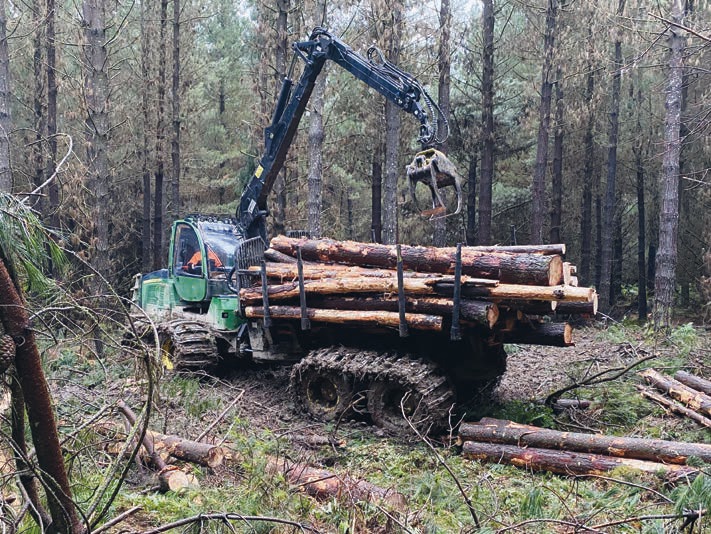
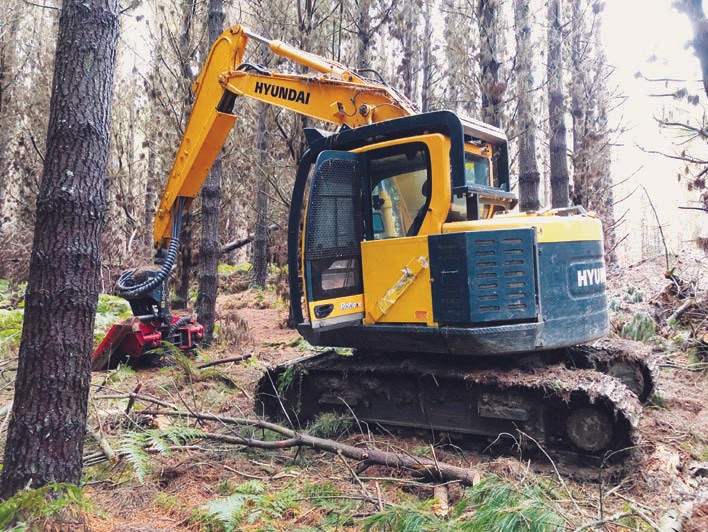
Comparing mechanisation
Based on our study and knowledge of the operation, we have estimated the costs of a fully mechanised thinning to waste operation – where log recovery and extraction was not carried out. These costs are summarised in the table below.
| Processor fell to waste cost per day | |
|---|---|
| Crew accessories | $79 |
| Power saw | $50 |
| Vehicle | $90 |
| Processor | $734 |
| Wages and one hour travel | $485 |
| Total | $1,438 |
Estimated number of trees per day – 224
- Estimated number of stems per hectare felled – 300
- Estimated number of hectares each day – 0.75
- Estimated cost per hectare – $1,917
In comparison, a conventional thin-to-waste operation carried out by a chainsaw crew could now be expected to cost $1,000 to $1,500 a hectare. Conventional thinning is unlikely to be feasible in older stands like the one in this study, where larger tree size leads to significantly increased safety concerns.
Conclusion
Production thinning has been a viable option in some New Zealand forests for decades. This is particularly true where forests are large, located within the supply circle of a significant pulp or chipwood market and have access and topography suited to mechanised operations.
We believe that increasing availability of smaller and highly sophisticated equipment, the change in tree harvesting from motor manual to mechanised and a wider variety of market options, are now opening up opportunities for smaller growers to consider production thinning as an alternative to early thin-to-waste stand treatment.
John Fodie’s Southland operation is an example where such operations can be viable for the contractor and forest owner. It may be marginally cost-effective for the forest owner in this scenario, but our view is that with further system development and refinement, such operations can become cost effective.
Residual stand damage in John Fodie’s operation was minimal. This was testament to the care and skill of the crew operators. It confirmed there is no reason why similar production thinning operations, common in other parts of the world and often on much more difficult topography, cannot become normalised practice in our industry.
Support and funding for this project was provided by New Zealand Forest Growers Research Limited and the New Zealand Forest Growers Levy Trust. We also acknowledge the assistance and co-operation from John Fodie and Roger Hill, and Forest Enterprises Growth Ltd, forest manager for New Forests Southland Estate Ltd where the study was undertaken.
John Schrider is a registered forestry consultant and Jack Palmer a forest engineer at Forme Consulting Group Ltd.

 Farm Forestry New Zealand
Farm Forestry New Zealand